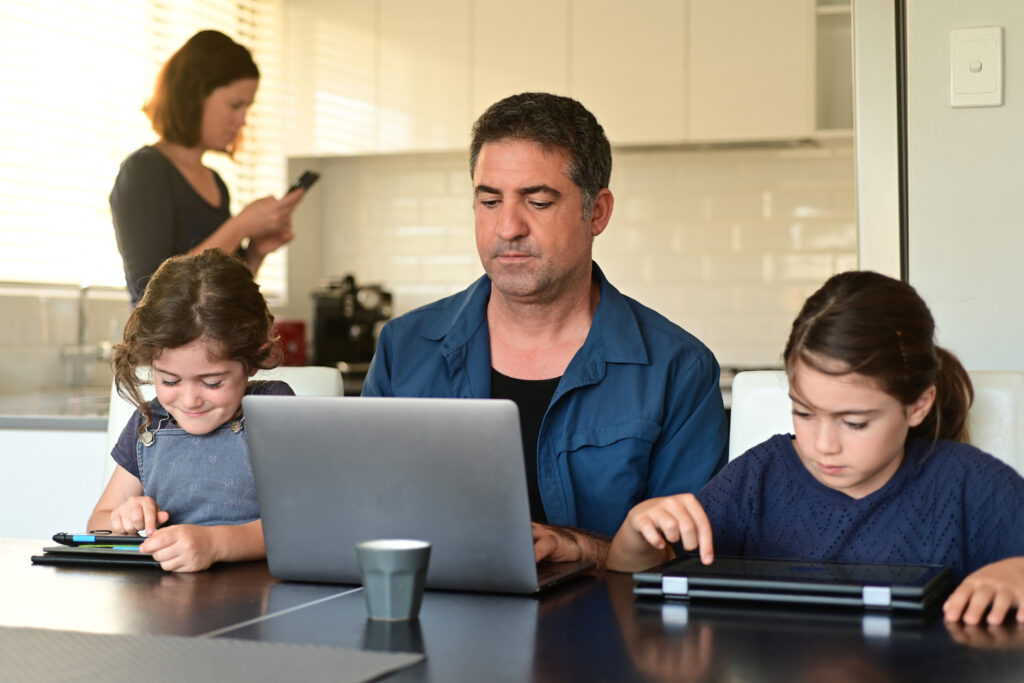
We have found ourselves in a new environment finding our way with restrictions on our day to day lives with the current Covid-19 pandemic. When something strikes that is outside of our control it is normal to feel overwhelmed, anxious and stressed. However, there are still aspects of our lives that we can put our energy and focus into. It is likely that we are spending more time with those with whom we co-habit. For many that means the household dynamics have changed, and parents and caregivers are now trying to juggle multiple roles at the same time including working from home, parental responsibilities, home-schooling and managing relationship dynamics to name a few!
It is important as a parent/caregiver to remember that there is no one size fits all approach to this and that you are no doubt already trying hard to find solutions for all that is happening in your home and life. It is important to remember that there is no need to be over productive unless this is normal for you – while we may appear to have more time available now, it is not necessary to fill every second of every day. Taking breaks and time to rest is vital.
When it comes to the parent/caregiver role, here are some areas that might be helpful for you – these can be adapted to be age appropriate.
- Establishing a household routine/ structure can be helpful as it can consider the needs of all family members and give each person a template from which they know what to expect for the day and week. Making space for study, chores, and fun would be great additions to this routine/structure.
- Encourage your child/adolescent to help where they can. Explain that everyone needs to help and ask your child how they feel they might be able to do this. Giving them a choice in how they do this facilitates their autonomy.
- Encourage open discussion, listening and communication. As a parent/caregiver you will need to adapt this to an age appropriate level for your child/adolescent and take into consideration your child’s needs and ability to understand a given situation. Your child/adolescent might have strong feelings at this time, and it is important to acknowledge these feelings and take any concerns seriously. While you may not be able to solve all of you their concerns – listening to and acknowledging their concerns without dismissal or the need to provide a solution can go a long way toward helping your child/adolescent to feel safe, understood and empowered.
- In this unique situation strong feelings, arguments and flared tempers are likely – For when this happens it is important to have a plan – such as leaving the room for 2 minutes to calm down or taking 10 consecutive deliberate breaths. This plan can be discussed among family members before it needs to be put into practice – often when things are calm and quiet is the best time to openly discuss your needs and safety plan for when things get heated. As this has been discussed previously, the other family member will know what is happening when you or they need to leave the room mid debate/argument.
- When you want to express yourselves – use ‘I Statements’ such as ‘I Feel’ or ‘I am hurt’ -this helps you and your family to own your feelings and for others around you to understand that they are not a target. It is easier to have positive communication when everyone is responsible in their delivery of their feelings/upset. Similarly, the act of apologising to your child/adolescent and vice-versa will allow you all to understand that everyone will sometimes act in a less than ideal way but that you are all able to make amends. As the parent/caregiver – your regular modelling of these skills will have a positive effect on your child/adolescent’s ability to put them into practice.
- As a parent whether cohabiting with your partner or not in a relationship with your child’s other parent it is important to remember that your children can probably hear more than you know. For that reason, it can be helpful to set aside time together to discuss any relationship or financial issues that may cause your child/adolescent distress and concern if they are to be privy to these conversations.
- Encourage time together as a family – this could be through eating meals together and playing games – this time will allow you to connect, laugh and enjoy yourselves while also creating a space in which your child can feel comfortable and may ask or discuss things they have been wondering about. If you have multiple children spending some alone time with each of them can allow them to know that you are there for them and that you value them as an individual.
- Encourage contact with family and friends online and over the phone where this is possible. This will help your child to understand that everyone is experiencing similar things to them now and it is still possible to maintain support and a sense of community even if we cannot be in physical proximity.
- Allow your child/adolescent to have their own space – they do not need to be with the family the whole time – let them know that you are available if they need you and ensure they are safe in what they are doing. This will help them to develop their ability to pursue their own independent activities and interests.
- Where possible provide access to play material including creative art materials and musical material to provide you child/adolescent with multiple mediums for expression.
- Screen time is a much-debated topic – at this stage you might notice your child is spending more time in front of a screen –either watching tv, doing schoolwork, chatting with friends and family or playing games. Deciding how much screen time you are comfortable with and relaying this to your child/adolescent establishes limits and boundaries.
- Your child/adolescent is likely to have access to information that you are not aware of – whether this is through friends, tv or online media. Be open to this and explain to them about fake news, online sources and staying reliably informed without overdoing media and news exposure. Depending on the age of the child they will be absorbing the information around them in different ways. You might notice references to illnesses, doctors and dying in your child’s artwork and play with their toys or through expressions of hopelessness with your adolescent. Helping them to understand the current situation with age appropriate information can allay their fears, help them feel heard and let them know that you are there for them.
Make time for yourself separate to the children and adolescents – even if it is 5 minutes before you fall into bed in the evening to take a moment and think about yourself, your feelings, your thoughts and your day. If you are not able to mind yourself and be kind to yourself it will be extra difficult to manage and provide for those around you.
Remember that this is a unique situation that we are all learning to navigate together. Over the course of this pandemic there will be multiple sources of information and places telling us what we should be doing or learning or achieving at this time. It is up to each and everyone of us to decide what we need and what our family needs currently.
Keeping open, honest, and age appropriate communication amongst the family and validating and hearing each other will go a long way. Remember also that there are multiple forms of support still available to you and your family such as those provided by Johnstown Therapy Centre if you feel that you and your family could benefit from extra support.


